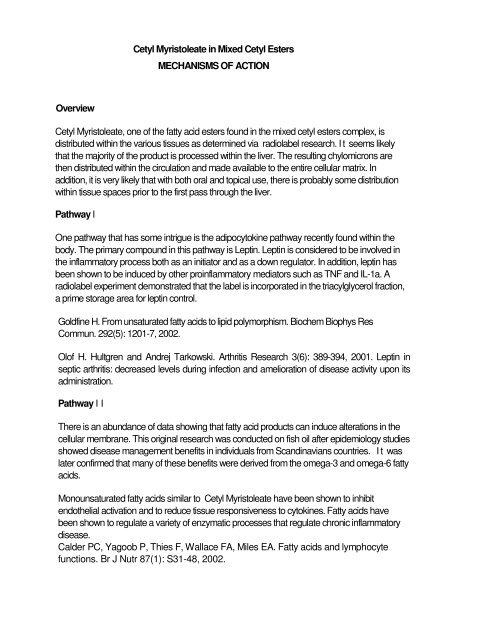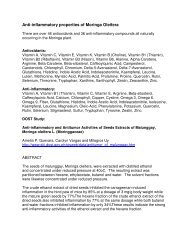Cetyl Myristoleate: Mechanisms of Action - OLEIA
Cetyl Myristoleate: Mechanisms of Action - OLEIA
Cetyl Myristoleate: Mechanisms of Action - OLEIA
You also want an ePaper? Increase the reach of your titles
YUMPU automatically turns print PDFs into web optimized ePapers that Google loves.
<strong>Cetyl</strong> <strong>Myristoleate</strong> in Mixed <strong>Cetyl</strong> EstersMECHANISMS OF ACTIONOverview<strong>Cetyl</strong> <strong>Myristoleate</strong>, one <strong>of</strong> the fatty acid esters found in the mixed cetyl esters complex, isdistributed within the various tissues as determined via radiolabel research. It seems likelythat the majority <strong>of</strong> the product is processed within the liver. The resulting chylomicrons arethen distributed within the circulation and made available to the entire cellular matrix. Inaddition, it is very likely that with both oral and topical use, there is probably some distributionwithin tissue spaces prior to the first pass through the liver.Pathway IOne pathway that has some intrigue is the adipocytokine pathway recently found within thebody. The primary compound in this pathway is Leptin. Leptin is considered to be involved inthe inflammatory process both as an initiator and as a down regulator. In addition, leptin hasbeen shown to be induced by other proinflammatory mediators such as TNF and IL-1a. Aradiolabel experiment demonstrated that the label is incorporated in the triacylglycerol fraction,a prime storage area for leptin control.Goldfine H. From unsaturated fatty acids to lipid polymorphism. Biochem Biophys ResCommun. 292(5): 1201-7, 2002.Ol<strong>of</strong> H. Hultgren and Andrej Tarkowski. Arthritis Research 3(6): 389-394, 2001. Leptin inseptic arthritis: decreased levels during infection and amelioration <strong>of</strong> disease activity upon itsadministration.Pathway I IThere is an abundance <strong>of</strong> data showing that fatty acid products can induce alterations in thecellular membrane. This original research was conducted on fish oil after epidemiology studiesshowed disease management benefits in individuals from Scandinavians countries. I t waslater confirmed that many <strong>of</strong> these benefits were derived from the omega-3 and omega-6 fattyacids.Monounsaturated fatty acids similar to <strong>Cetyl</strong> <strong>Myristoleate</strong> have been shown to inhibitendothelial activation and to reduce tissue responsiveness to cytokines. Fatty acids havebeen shown to regulate a variety <strong>of</strong> enzymatic processes that regulate chronic inflammatorydisease.Calder PC, Yagoob P, Thies F, Wallace FA, Miles EA. Fatty acids and lymphocytefunctions. Br J Nutr 87(1): S31-48, 2002.
Mata P, Alonso R, Lopez-Miranda 3, et al. Effect <strong>of</strong> dietary fat saturation on LDL oxidation andmonocyte adhesion to human endothelial cells in vitro. Arterioscler Thromb Vasc Biol 16:1347-1355, 1996.Perez-Jimenez F, Castro P, Lopez-Miranda J, et al. Circulating levels <strong>of</strong> endothelial functionare modulated by dietary monounsaturated fat. Atherosclerosis 145: 351-358, 1999.Vicennati V, Vottero A, Friedman C, Papanicolaou DA. Hormonal regulation <strong>of</strong> interleuki-6production in human adipocytes. Int J Obes Relat Metab Disord 26(7): 905-911, 2002.Zaloga GP, Marik P. Lipid modulation and systemic inflammation. Crit Care Clin 17(1): 201-217,2001.Pathway I I IArachidonic acid is one <strong>of</strong> the primary mediators for inflammation. Fatty acids from fish oil havebeen shown to decrease the amount <strong>of</strong> arachidonic acid in cell membranes reducingeicosanoid production via cyclooxygenase and lipoxygenase. It is the integration betweenarachidonic acid byproducts and their involvement with leukotriene and proglandins that leadsto inflammation control. It is believed that the fatty acid esters within the cetyl myristoleatecomplex work to limit this eicosanoid production and thereby reduce the inflammatory cascade.Bandeira-Mel C, Bozza PT, Weller PF. The cellular biology <strong>of</strong> eosinophil eicosanoid formationand function. 3 Allergy Clin Immunol 109(3): 393-400, 2002.Calder PC 1 Grible RF. Polyunsaturated fatty acids, inflammation and immunity. Eur J Clin Nutr56(3): S14-9, 2002.Fabre JE, Goulet JL, Riche E, Nguyen M, Coggins K, Offenbacher S, Koller BH. Transcellularbiosynthesis contributes to the production <strong>of</strong> leukotrients during inflammatory responses invivo. J Clin Invest 109(10): 1373-80, 2002.Kroetz DL, Zeldin DC. Cytochrome P450 pathways <strong>of</strong> arachidonic acid metabolism. Curr OpinLipidol 13(3): 273-83, 2002.Pathway IVThere is new, compelling evidence showing that fatty acids have pr<strong>of</strong>ound impact on cellularregulation and communication (Holthus et al 2001). The primary organs for this process arethe endoplasmic reticulum and Golgi body apparatus. These two cellular structures are themain manufacturers <strong>of</strong> the cellular signals within the body. While direct evidence for the cetylmyristoleate complex is not available at the present, it is believed that the immediate benefitfound with topical cream containing cetyl myristoleate can only be explained by such rapidcellular communication and regulation.
One area that has great potential is the interplay between fatty acid ester compounds andsphingolipids. Sphingolipids are essential for cellular function and are uniquely integrated withthe endoplasmic reticulum and Golgi bodies. Sphingolipids are considered dynamic regulators<strong>of</strong> cellular processes. It is the variable structure <strong>of</strong> sphingolipids and glycerolipids that triggerthe formation <strong>of</strong> microdomains or rafts within the membrane. Spingolipids are traditionallybased upon a C18 fatty acid backbone but over 60 different species have been described withchain lengths varying from 14 to 20 carbons differing in saturation and hydroxylation.The influence <strong>of</strong> dietary manipulation <strong>of</strong> these membrane components have been shown invitro. Yao et•al (2002) demonstrated that stearic acid and EPA could alter the endoplasmicreticulum to Golgi body lipid trafficking compared to oleic acid. One result was an inhibition <strong>of</strong>ER lipid synthesis and transfer <strong>of</strong> membrane lipids to luminal particles. In addition, it wasrecently demonstrated that the polyunsaturated fatty acid mediation <strong>of</strong> T cell inhibition wasattributable to signal protein displacement in membranes (Zeyda et al. 2002). It was thealteration in lipid rafts that was identified as the primary loci. The authors concluded that thealtered lipid raft membrane distribution could also underlie the clinically apparentimmunosuppressive action <strong>of</strong> PUFA's in patients with inflammatory disease.Holthus JC, Pomorski T, Raggers RJ, Sprong H, Van Meer G. The Organizing Potential <strong>of</strong>Sphingolipids in Intracellular Membrane Transport. Physiological Reviews 81(4): 1689-1723,2001.Zeyda M, Staffler G, Horejsi V, Waldhausl W, Stulnig TM. LAT Displacement from LipidsRafts as Molecular Mechanism for Inhibition <strong>of</strong> T Cell Signaling by Polyunsaturated Fatty Acids.J Biol Chem. Aug 9;277(32):28418-23, 2002. Yao Y, Eshun JK, Lu S, Berschneider HM, BlackDD. Regulation <strong>of</strong> triacylglycerol and phospholipid trafficking by fatty acids in newborn swineenterocytes. Am J Physiol Gastrointest Liver Physiol 282: G817-824, 2002.



